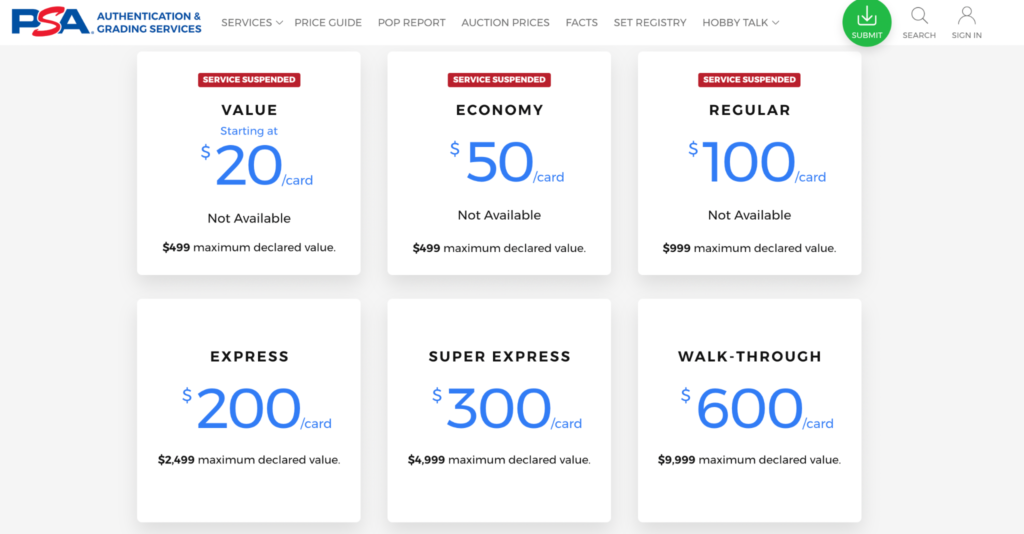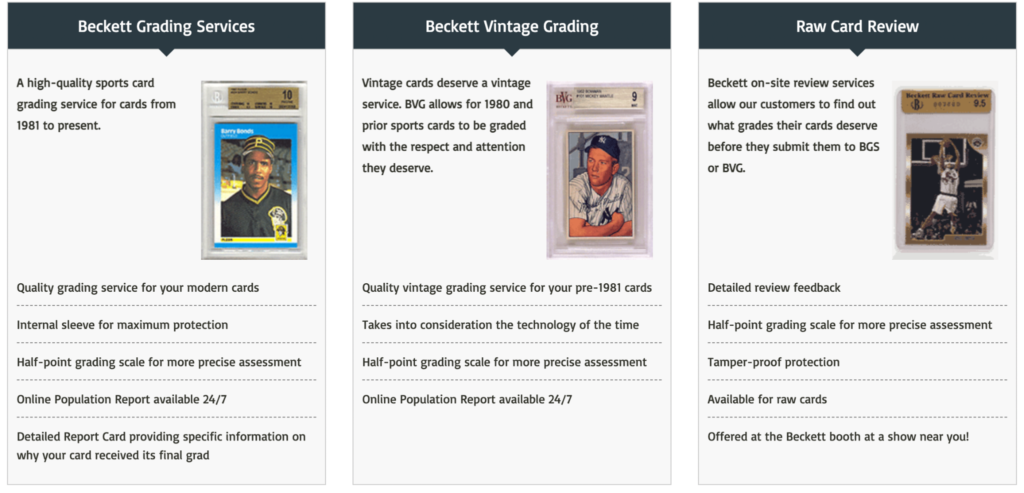If the recent trends in sports card prices have sent you digging in your childhood closet for your old collection, you might now be asking yourself: are my cards worth anything?
- Hallmark Pack of 20 Thank You for Your Sympathy Cards, Cherry Blossom (Funeral Thank You Cards)
- How to Submit your cards to PSA 2023 – Complete Guide
- A Complete Guide to Sending Celebration of Life Thank-You Cards
- Learning the PSA Grading Scale7 min read
- Where to Buy Wedding Envelopes for DIY Wedding Invitations
In order for your card to be worth any money, in most cases you’ll need to send it in for grading. This is not a trivial task or cost—especially now that these services have been paused due to an extreme backlog. We’d recommend that you get a basic grasp on how sports card grading works to determine if it’s worth it.
You are watching: PSA Grading & BGS Grading: A Guide
The Value of Card Grading

The fundamental purpose of grading is to ensure the authenticity of cards, but grades can also make or break the value of a card. As many now know, even a half grade can make the difference of thousands of dollars.
With sports card collecting transitioning into quite a valuable hobby, the establishment of sports card grading companies became necessary to establish a level playing field for collectors. To remain unbiased, third-party grading companies can’t hold any monetary stakes in collectors’ graded cards. Thus, these companies could provide a reliable and trustworthy source of authority.
Before sports card grading, collectors used to purchase raw cards with a grain of salt. With the rise of grading, raw cards are now less reliable to collectors and viewed as less valuable. That’s because after a sports card receives a grade, it’s encapsulated in a cardholder, which prevents the card from damage—including from anyone trying to tamper with the card.
Through the years, collectors have grown comfortable with sports card grading, and card grading standards have become more familiar. Sports cards grading gives assurance to collectors that their cards will have a greater likelihood of retaining long-term value, both via the authoritative grade and the physical protection from the cardholder encapsulation.
How Sports Cards Are Graded
PSA and BGS are two sports and trading card grading companies that use a standard 1-10 scale. In addition to this scale, BGS also uses the 9.5 half point. PSA avoids this. PSA grading fees quickly exceed BGS grading fees. Both models increase in price with tier, but PSA has more premium-priced tiers.
You may be wondering how exactly grading companies grade these sports cards—it’s quite straightforward! Each card receives a numeric grade ranging from 1-10, with 10 signifying the highest attainable grade. Half grades may apply, depending on the card grading company and the particular circumstances.
The numeric grade is based on four categories: centering, corners, edges, and surface. A higher numerical grade indicates a more pristine card. Lower graded cards will show centering concerns, printing defects, and wear of edges and corners.
10 is the highest overall grade a sports card can receive, though BGS also offers a Black Label Pristine 10, which means the card received a 10 for all four subgrades. While a Black Label Pristine 10 and PSA 10 are the highest grades a card can obtain, that isn’t to say that other grades aren’t of value.
Typically for modern cards, a grade of a 9 or 10 is paramount because recently released cards should maintain pristine condition. On the other hand, vintage cards can have low grades like a 2 or 3 and still be worth millions of dollars, such as a 1909-1991 T206 Honus Wagner card. Because the T206 set was issued over 100 years ago, there is a strong likelihood that the highest overall condition of a card from that era only merits a PSA/BGS 2 or 3.
The value of a graded sports card comes down to condition and scarcity. A card with a high population and a high percentage of cards graded in pristine condition may not be as valuable as a card with a high population but low percentage of cards in pristine condition.
On the flip side, a card with a low population and a high percentage of cards graded in pristine condition may not be as valuable as a card with a low population but a low percentage of cards graded in pristine condition.
Centering
The perception of centering is crucial in the field of sports cards. While all categories are equally important when obtaining a grade, the centering of a card is vital if you elect to sell the card in the future, as poor centering may not provide as much value.
A grading card company only awards a 10 if the card is nearly perfectly centered. When a card grader looks at centering, they essentially divide up the card as left/right and top/bottom while measuring what percentage of the card is off-centered. A card that measures 50/50 (meaning 50% of the card lies on the left/right side, and 50% lies on the top/bottom) is considered perfectly centered.
According to PSA’s grading standards for a PSA 10, the front of the card must measure between 55/45 to 60/40 and 70/30 on the reverse. BGS presents even less leeway, as a BGS 10 requires 50/50 on the card’s face and 60/40 on the back.
Before sending a card for grading, collectors can apply the Original GradeMaster Card Centering Tool, enabling collectors to measure the centering of their sports cards.
Corners
The fraying of the corners for raw sports cards is inevitable over time. With the proper storing of sports cards, and in particular having a card graded, collectors can prolong their collections.
A card may appear to have pristine corners to the naked eye, but card grading companies examine the card under magnification to warrant the condition. Both PSA and BGS require perfect corners for a card to receive a grade of 10.
Edges
Like corners, the edges of sports cards are prone to deterioration. The edges are predisposed to chipping, which exposes white borders on the card. For a card to earn a 10, the edges of a card must be flawless to the naked eye and virtually perfect when looked at under magnification.
Surface
The final criteria looked at by card graders is the surface of the card. A card’s surface is susceptible to loss of glossiness, wax stains, scratching, and printing defects. Sports cards are highly sensitive to surface deterioration.
Overview of PSA & BGS
PSA and BGS are the most reputable sports card grading authenticators, and the price summoned from these two leading grading services is proof of that. Both companies are reputable, trustworthy, and highly recommended to grade your treasured sports cards.
Professional Sports Authenticator

Since launching in 1991, PSA has verified more than 40 million sports cards and collectibles, with a total value surpassing $1 billion. PSA also features PSA/DNA, a division that concentrates specifically on grading collectibles and other memorabilia.
PSA aims to analyze sports cards and ensure they are authentic while presenting the certification of each card. Provided that you grade your sports cards with PSA, collectors can streamline their collections with the Sports Market Report, Set Registry, and Population Report to assess their collection.
Beckett Grading Services

Before the emergence of Beckett Grading Services, James Beckett III, a prolific statistician, tirelessly tracked the baseball card market, producing the industry’s most recognized baseball card price guide in 1979. Following the success of Beckett’s price guides, Beckett Media emerged as the face of collectibles.
Like PSA, Beckett has subdivisions to Beckett Grading Services. Launched in 2001, Beckett announced Beckett Vintage Grading (BVG), catering to vintage sports cards pre-1981. If you’re intrigued by sports card shows, you should capitalize on Beckett’s Raw Card Review. Beckett organizes a booth at card shows and gives collectors an in-depth review of their cards while presenting what cards collectors should obtain when submitting to BGS or BVG. What’s more, Beckett offers Beckett Authentication, providing collectors with certification for autographed memorabilia.
PSA vs. BGS Labels
When PSA and BGS grade a sports card, the card is encapsulated in a tamper-evident holder with a label that provides collectors with specific information regarding the card’s condition, authenticity, and uniqueness. While both grading companies present the player, card manufacturer, grade, and unique barcode, the two slabs differ significantly.
Meet the PSA Label
The front of PSA’s label emphasizes a recognizable red border with a white background that features “fugitive ink” to prevent tampering. Like a standard bank check, fugitive ink will wash away if any cleaning products compromise the card. A PSA label also unveils Lighthouse technology, creating a holographic effect that reveals PSA’s logo. The reverse of PSA’s label showcases a PSA Lighthouse logo and a QR Code. When collectors scan the QR code, they can find the certification verification of the card to confirm authenticity. The reverse also introduces an ultraviolet PSA logo that glows when exposed to UV light.
Meet the BGS Label
The BGS label is color-coded to reflect the card’s grade. If a card receives four sub-grades of 10, the ultimate grade from BGS, the card flaunts a distinctive black label. A gold label is issued for a BGS 10 and 9.5, a silver label for a BGS 9 and 8.5, and the remaining graded cards feature a white label.
Differing from PSA, the front of a BGS graded card provides the numerical grade for each of the four subgrades of a card. Many collectors feel that the subgrades of BGS help give a better sense of the card without needing to see the asset in real life.
PSA & BGS Autograph Grading
As strictly an autograph authentication service, PSA launched PSA/DNA in 1998, focusing on authenticating autographs and memorabilia. PSA/DNA analyzes and grades collectible items encompassing the sports world, music and entertainment industry, along with politics and history.
PSA provides Autograph Authentication, Autograph Encapsulation and offers Card and Autograph Dual Grading. With Autograph Authentication, PSA examines collectors’ autographed collectibles to establish if a signature is authentic.

PSA’s Autograph Encapsulation allows collectors to submit autographed cards, photographs, among other collectible items, to become graded and encapsulated with a numeric grade. One of the perks of this service provides collectors with an alternative to the traditional certificate of authenticity, though you’ll receive a COA as well.
Last but not least, PSA offers its customers Card and Autograph Dual Grading. With this approach, collectors can submit an autographed sports trading card to PSA and receive a grade for both the card and autograph. PSA uses their traditional 1-10 grading scale for autographs, determined by the overall quality of the signature.
BGS also offers an authentication service for autographs, termed Beckett Authentication Services (BAS). BAS provides collectors with expert grading for all genres of autographs, from vintage to modern sports autographs, together with the entertainment and historical disciplines.
BGS graders use expert analysis to analyze the signature and the ink of memorabilia. When an autograph is deemed authentic, the item receives a tamper-evident label and a BAS Certification Number on top of a COA. When a verified autograph is recorded in Beckett’s online database, collectors can enter their certification or serial number to maintain a record of authenticity.
How Much Does PSA & BGS Cost?
Before jumping into the expense of sports card grading, it’s essential to review the concept of the declared value and how it affects the submission process and cost of grading. The declared value is essentially the appraised value of a card after being successfully submitted and graded by PSA or BGS. Depending on the anticipated declared value, a collector will pay for grading based on specific tiers. The specific tiers vary in declared value, pricing, and turnaround time.
Read more : Personalised Birthday Cards
A collector uses the declared value to estimate the condition of their card and estimate what grade they expect to receive after the card is graded. To help collectors through the process, both PSA and BGS have tools to determine a card’s value. PSA has a Sports Market Report Price Guide, Auctions Prices Realized, and a comprehensive population report. BGS has an in-depth population report and a graded Card Lookup to help determine the value of a card.
On occasion, a card receives a grade higher than its declared value. In this case, PSA and BGS may reach out to request a higher fee from collectors. However, the declared value is in position in the unlikely event of an issue with your card, and PSA or BGS has to provide collectors with the replacement value of the card. With too low of a declared value, collectors will have less protection for their cards. With the appropriate declared value, the submitter and grading company are both protected.
PSA Card Authentication & Grading Pricing

Before suspending services due to a backlog, PSA offered various card authentication and grading services. For PSA’s Value services, their most basic tier, it cost $20/card, though there is a minimum submission of 10 cards, with a cap of $499 declared value. They also offered an Economy service fetching $50/card, with a maximum $499 declared value. The next tier is PSA’s Regular service, drawing $100/card, with a $999 declared value. PSA also introduces an Express service commanding a price of $200/card with a $2,499 declared value, Super Express service for $300/card and $4,999 declared value, and Walk-Through service for $600/card with a $9,999 declared value.
If a card merits a declared value between $24,999 and $250,000, PSA has Premium Options available:
For $1,000/card, a card can have a maximum declared value of $24,999.
For $2,000/card, a card can have a maximum declared value of $49,999.
For $3,000/card, a card can have a maximum declared value of $99,999.
For $5,000/card, a card can have a maximum declared value of $249,999
For $10,000/card, a card has a declared value of $250,000 or more.
Beckett Grading Services Pricing

Also encountering a backlog, BGS has likewise suspended several of its card grading services. Before the excess of sports cards submitted for grading, BGS offered various tiers for Beckett’s card grading services. Depending on whether you wish to have sub-grades, the cost of submitting cards to BGS varies.
The BGS Standard service carries $30 with no sub-grades and $50 with sub-grades. For their Economy service with no sub-grades, a card commands $20/card and $35/card with sub-grades. Express services cost $100/card with no sub-grades and $150/card with sub-grades. The only available service from BGS is their Premium service that sets collectors back $125/card for no sub-grades and $250/card with sub-grades.
Is PSA Grading or BGS Grading worth it?
The concept of grading sports cards is to ensure authenticity and increase the value of a card. Though, not all sports cards are worth grading. Concerning the long-term value of sports cards, grading is only worth it for cards that will carry more money after being graded by PSA or BGS. Grading sports cards are a costly endeavor, especially now with just thin service options available from PSA and BGS. If your card isn’t worth more than the value of the service fees of grading, then you shouldn’t grade that particular sports card.
Also, remember that condition is at the core of the value of the card. While a graded sports card will typically carry more value than a raw sports card, it’s imperative to research your cards to discern if having a card graded will ultimately increase the card’s value.
Latest Announcements
Before the coronavirus pandemic, PSA encountered more submissions than ever, leading to extensive delays and a backlog of ungraded sports cards. In March 2020, the pandemic forced PSA to shut down their New Jersey and California facilities.
With an excess of cards, PSA suspended Value, Economy, and Regular submissions. PSA currently offers Express service for $200/card, Super Express for $300/card, and Walkthrough for $600/card. If your card has a declared value of over $1,000, PSA offers Premium options that take just one business day, though $1,000/card is far from nickels and dimes.
While PSA no longer offers turnaround time, they implemented Call Through Dates (CTD). These CTD’s are essentially a way for collectors to discern where PSA stands in their fulfillment of graded cards by service level. To contend the backlog, PSA continues to hire more customer service personnel and unveiled the Customer Request Center, aiming to streamline the customer service of PSA.
Facing a similar situation, Beckett also faces a backlog of cards. As of June 7, 2021, Beckett suspended all grading services other than their Premium Level. Jeromy Murray, named Beckett’s President earlier this year, set the target date of July 28, the start of the 41st National Sports Collectors Convention in Chicago, to process, grade, and return the bulk of customers’ cards.
But as it stands, Beckett’s Economy, Standard, and Express Level services remain suspended. The only passage for collectors to have a card graded by Beckett is to dish out $250 for their Premium Level service. We could only hope that Beckett issues an announcement soon about the backlog and when to expect the entryway to additional service levels and faster turnaround time.
Looking Ahead
The grading of sports cards remains in place to ensure authenticity and increase the value of sports cards. Since the appearance of sports card grading companies in the 80s, the sports card market has advanced and become an attractive alternative investment.
Despite PSA and Beckett’s services remaining suspended, perhaps we should view the extensive delays as evidence of furthering the sports card landscape. Maybe we should use this time to reflect on the evolution of sports cards and anticipate a promising future.
Source: https://antiquewolrd.com
Categories: Cards & Envelopes

